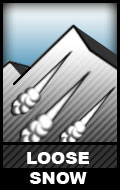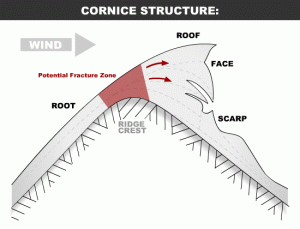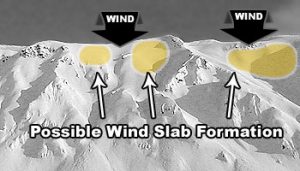Avalanche Danger Forecast
Issued Tuesday, February 16, 2021 at 10am for the greater Anchorage area Western Chugach Mountains (i.e. Chugach State Park). View map of primary forecast area here.
Avalanche danger will increase Tuesday (from moderate) into Wednesday (to considerable) due to new snow and wind.
Small wind slabs, loose dry avalanches, and small to medium sized persistent slabs will be possible for humans to trigger Tuesday.
On Wednesday, naturally triggered small to medium sized wind and persistent slabs are possible. Human triggered small to medium sized wind and persistent slabs are likely.
The weather late Wednesday through Thursday is less clear, but both natural and human triggered wind and persistent slab avalanches are possible. Storm slab and loose dry avalanches may also be a problem if there’s more new snow with less wind.
Cornices have developed in the upper elevations throughout the park and new snow and strong wind this forecast period may make them more prone to failure and falling.
Mountain Weather:
Tuesday: snow in the morning with rising cloud ceiling later, alpine temps in the 20s, light easterly to southerly wind (moderate to strong east to south wind developing overnight)
Wednesday: cloudy with a chance of snow later in the day, alpine temps in the 20s, moderate to strong east to south wind becoming light to moderate later in the day
Thursday: cloudy with a chance of snow, alpine temps in the 20s, light to moderate easterly to southerly wind
Discussion:
We are receiving a much needed refresh (for snow lovers and riders) of a few to several inches of new snow through midday Tuesday in the greater Anchorage area Western Chugach. A couple inches had already accumulated in East Anchorage as of 6am Tuesday and snowfall was intensifying. The radar earlier this morning showed heavier bands of snow in the Front Range and Turnagain Arm areas with bands of snow building in the Knik Arm and Eagle River areas. Local snotels weren’t reporting any new SWE, except at Indian Pass (.2″), but this is likely an inaccurate representation as local webcams were showing new snow on the ground. The National Weather Service is suggesting a snow:liquid ratio of 20:1, which would make for low density and high quality powder.
Tuesday’s snowfall, that arrived with light to moderate (easterly to southerly) wind, will repair widespread wind-damaged surface snow that has made for generally awful riding conditions in recent days (and not much better hiking-climbing conditions as the widespread wind-affected snow was breakable windboard in many areas).
Unfortunately, it seems new snow will not remain unmolested by the wind beyond Tuesday evening as strong winds are forecast to develop late Tuesday and last through at least Wednesday morning. These winds are expected to make for the most significant spike in avalanche danger this forecast period, as well as degrade surface conditions for riding.
On the bright side, while the greater Anchorage area Western Chugach will initially be in the downslope rain shadow as a storm in the Gulf primarily impacts coastal areas of Prince William Sound, more snow with less wind is possible later Wednesday and Thursday. Cross your fingers.
Beyond the widespread wind-affected snow and generally bad surface conditions for riding over the President’s Day weekend, observations did reveal some beneficial news for the snowpack. A strong inversion developed Friday and alpine temperatures over the weekend increased enough to significantly improve the temperature gradient within the snowpack. Sunshine Friday-Sunday further enhanced a beneficial temperature gradient for bonding and stabilization on solar aspects without creating any observed crusts.
While we did not really expose ourselves to steep, unsupported, and/or convex wind loaded areas; we found the widespread wind-packed layers (i.e. wind slabs) near the surface to be bonding well to the looser and weaker near surface facets below without much reactivity to human triggers on Saturday and Sunday.
Again, while we practiced effective terrain management and avoided heavily wind loaded terrain (especially if steep, unsupported, and/or convex), we did not observe any red flags of persistent slab danger nor did we find any to be reactive to human triggers. That being said, a variety of basal weak layers remain widespread.
Avalanche Problems:
 Both natural and human triggered wind slabs up to D2 in size are possible to likely above 2500′ on leeward terrain steeper than 35º.
Both natural and human triggered wind slabs up to D2 in size are possible to likely above 2500′ on leeward terrain steeper than 35º.
Strong winds late Tuesday through at least Wednesday morning will build fresh wind slabs from Tuesday’s snowfall.
On Wednesday, it will be especially important to be mindful of the wind slab danger. As several popular trails in Chugach State Park (e.g. Penguin Ridge and Falls Creek from Turnagain Arm, Powerline from Glen Alps, the South Fork Eagle River trail approaching Eagle Lake) cross potentially dangerous avalanche paths, it will be important to be mindful of steep terrain above you and overhead avalanche danger even if you’re on a relatively flat trail. Naturally triggered avalanches in the upper elevations Wednesday may run into mid and lower elevation terrain and cross trails.
As the weather forecast for Thursday is unclear, the wind slab danger then may increase further or decrease. An increase in wind slab danger will be relative to any new snow and/or wind. Pay attention to the weather to assess this on your own where you plan to recreate.
Active wind loading, recent avalanches, and shooting cracks are red flag indicators of wind slab danger. Wind slabs are most likely to exist below corniced areas and along the lee sides of ridges and cross-loaded features like gullies:
Relatively densely-packed (firm and “punchier” feeling) snow and pockets of deeper snow (especially with a bulbous or fat appearance) are indicators of wind slabs. If you look closely at the snow surface you may be able to distinguish where wind slabs exist due to the snow having a more textured, densely-packed, consolidated, cohesive, and/or striated appearance. Be especially wary of (and avoid) steep, convex, and/or unsupported wind loaded terrain features.
Pole probing and hand pits are a quick and effective means of assessing this problem as you travel. Use pole probing to quickly feel out areas of denser, wind-packed snow overlying looser and weaker snow. Use hand pits to quickly assess how near-surface layers of snow are bonded.
Digging a snowpit and conducting a compression test and/or extended column test will provide an even better assessment of bonding and instability before you travel on terrain of consequence.
You can also assess wind slab instability via safer “test slopes” that are representative of higher consequence terrain.
Both natural and human triggered persistent slabs up to D2.5 in size are possible above 2500′ on terrain steeper than 35º.
While persistent slabs exist on all aspects, expect the problem to be the most pronounced on recently wind loaded terrain and shadier and colder northerly aspects (where persistent weak layers are less stable due to a bad snowpack temperature gradient).
The persistent slab problem is lower probability, but potentially much higher consequence, than the wind slab problem. Persistent slabs triggered this forecast period may be hard slabs that break deeper down in the snowpack and release above and around a human trigger (rather than at the trigger’s feet) which can make escape difficult. Hard slab avalanche debris is also more likely to cause trauma than debris from soft slabs.
Be on the lookout for red flag warnings of persistent slab danger: recent avalanches, collapsing (aka “whumphing“), and shooting cracks.
Diverse and widespread persistent weak layers exist in the snowpack. Faceted snow exists above and below crusts in some areas, sandwiched between wind packed layers in many areas, and a basal weak layer of advanced facets and depth hoar is widespread. Surface hoar was observed in some areas last week and last and it may have been buried intact in isolated mid elevation locations where it could be problematic. While dangerous terrain where intact buried surface hoar exists is likely very limited, keep it in mind if you’re traveling around mid elevation terrain traps.
 Dry loose snow avalanches (human triggered sluffing and naturally triggered spindrift) are possible above 3000′ on steep terrain (38º+) across all aspects.
Dry loose snow avalanches (human triggered sluffing and naturally triggered spindrift) are possible above 3000′ on steep terrain (38º+) across all aspects.
While these relatively small avalanches (D1) aren’t much of a concern in regard to burial, they do have the potential to cause a fall or loss of control. While not likely, it’s possible that a loose snow avalanche could trigger a larger wind or persistent slab as it descends a slope.
Don’t let a loose snow avalanche catch you off guard. Manage your sluff if descending steep terrain via ski or snowboard. If it happens to be windy and you’re climbing steep and/or exposed terrain, be mindful of the potential for heavy spindrift that could knock you off your feet and take you for a (potentially deadly) ride.
Both natural and human triggered cornice falls are possible. Cornices are large and overhanging in some areas above 3000′. New snow and strong wind this forecast period will make them more prone to failure and falling.
Give cornices a wide berth and don’t approach the edge of a ridge line to look down slope unless you’re sure it’s not corniced. Cornices can break off further back than expected (even beyond the true edge of the mountain ridge beneath the snow surface). In addition to the danger of taking a nasty fall due to a collapsing cornice, a falling cornice may “bomb” the slope it lands on and trigger an avalanche.
Terrain management is always the best way to deal with avalanche problems: eliminate or reduce your exposure to terrain capable of producing an avalanche. Before traveling on or under terrain that has the potential to avalanche think about the consequences and have a plan (to escape the avalanche, for re-grouping, and rescue).
Always be mindful of terrain traps that can make even a small avalanche deadly.
Click the hyperlinks and icons to learn more.
Please let us know what you’re seeing by tagging us on Instagram @anchorage_avalanche_center, submitting an observation, sending an email to info@anchorageavalanchecenter.org, or via FaceBook message. All observations help us provide the public with a better forecast product (no matter how basic). We can keep your observation confidential, and only use the information to inform forecast products.





